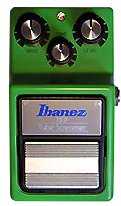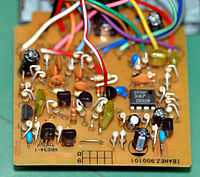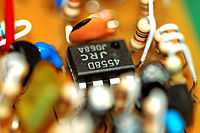Ibanez Tube Screamer

The Ibanez Tube Screamer is a guitar overdrive pedal, made by Ibanez. The pedal has a characteristic mid-boosted tone popular with blues players. The "legendary" Tube Screamer has been used by guitarists such as Stevie Ray Vaughan to create their signature sound, and is one of the most popular and most copied overdrive pedals.[1]
Description
The pedal has a drive knob, a tone knob, and a level knob. The drive knob adjusts gain, the tone knob adjusts treble and the level knob adjusts the output volume of the pedal. The pedal is used to try to mimic the sound of a vintage tube amplifier. The classic Tube Screamer sound includes a "mid-hump," which means that the circuit accentuates frequencies between the bass and treble ranges (mid-frequencies). Many guitarists prefer this sort of equalization, as it helps to keep their sound from getting lost in the overall mix of the band.
Variations
The pedal was produced with many variants. The early incarnations of the TS-808 (with and without hyphen)[1] and TS9 are the most sought-after by collectors. Other variants, including the TS10, TS7, and TS5 are less collectible and vary in their reproduction of the original circuit. The TS9 and TS-808 pedals have been reissued, and according to the company, feature the same circuitry, electronics and design components that helped shape the famous Tube Screamer sound. Some musicians have a technician perform modifications to the unit to change the sound to their liking. Also, Maxon, who produced the original Tube Screamer pedals for the Ibanez brand in the 1970s and 1980s, produce their own version of the Tube Screamer. Many of the most highly regarded overdrive pedals, both mass-manufactured (e.g., BOSS SD-1) and boutique (e.g., Fulltone Fulldrive 2 MOSFET), owe their heritage to the Tube Screamer circuit.
Design

Mr. S. Tamura, the designer of the Tube Screamer, used a subtle clipping circuit to create the pedal's sound. He mixed the input signal with the output signal of the clipping circuit, to "preserve the original dynamics of the input signal which otherwise would get lost at the threshold of clipping." In this fashion, it preserves the "original dynamics of the input signal [and] avoids muddiness and vastly improves clarity and responsiveness." As well, Tamura added a post-clipping equalization circuit with a first-order high-pass shelving filter that "is linearly dependent on its gain," an approach called "progressivity."[2] Characteristic of its clipping is the symmetrical nature.[3]
The Tube Screamer uses electronic field-effect transistor (FET) bypass switching. The circuit uses transistor buffers at both the input and the output. The overdrive is produced using a variable gain operational amplifier ("op-amp") circuit with matched diodes in the feedback circuit to produce soft, symmetrical clipping of the input waveform. The overdrive stage is followed by a simple low-pass filter and active tone control circuit and volume control. The TS7 allows switching between a "TS9" mode, in which the circuit and all relevant component values are identical to the vintage model, and a "Hot" mode, which introduces an additional gain stage.

Much has been made of the operational amplifier chips used in the various versions of the Tube Screamer pedal, and several articles have been written on the subject.[4][5] The JRC4558D chip is particularly well regarded.[1] In fact, the JRC4558D is used in Analog Man's "Silver" modification. Other popular chips included the TL072, RC4558P, and OPA2134. The TA75558, standard in the TS10 alongside the 4558, is regarded as the "ugly duckling of TS opamps."[1]
Yet another variant is the Ibanez ST9 Super Tube that features a fourth knob ("Mid Boost"), which provides a harder attack.
Notable users
The pedal was popularized by Stevie Ray Vaughan. It is widely used in genres as diverse as country, blues and shred. The Tube Screamer has since spawned many clones and modified versions.[6] It is also used by the majority of metal guitarists before the lead channel of the high gain amps to make distortion more focused and to cut the low end. Notable modifiers of the pedal include Robert Keeley of Keeley Electronics.[7]
References
- ↑ 1.0 1.1 1.2 1.3 Hunter, Dave (2004). Guitar effects pedals: the practical handbook. Hal Leonard. pp. 68–71. ISBN 978-0-87930-806-3.
- ↑ Topaktas, Bogac. "Tube Screamer’s Secret". BTE Audio. Retrieved 13 September 2010.
- ↑ Zölzer, Udo; Xavier Amatriain (2002). DAFX: digital audio effects. John Wiley and Sons. p. 125. ISBN 978-0-471-49078-4.
- ↑ "Ibanez Tube Screamers History". Analogman.com. Retrieved 13 September 2010.
- ↑ Möller, Andreas. "The "true" TS-808 chip ...". Stinkfoot Electronics. Retrieved 13 September 2010.
- ↑ "Ibanez Tube Screamer". musicradar.com. Retrieved 1 September 2011.
- ↑ Tucker, Lindsay (November 2011). "Builder Profile: Keeley Electronics' Robert Keeley". Premier Guitar. Retrieved 20 January 2012.